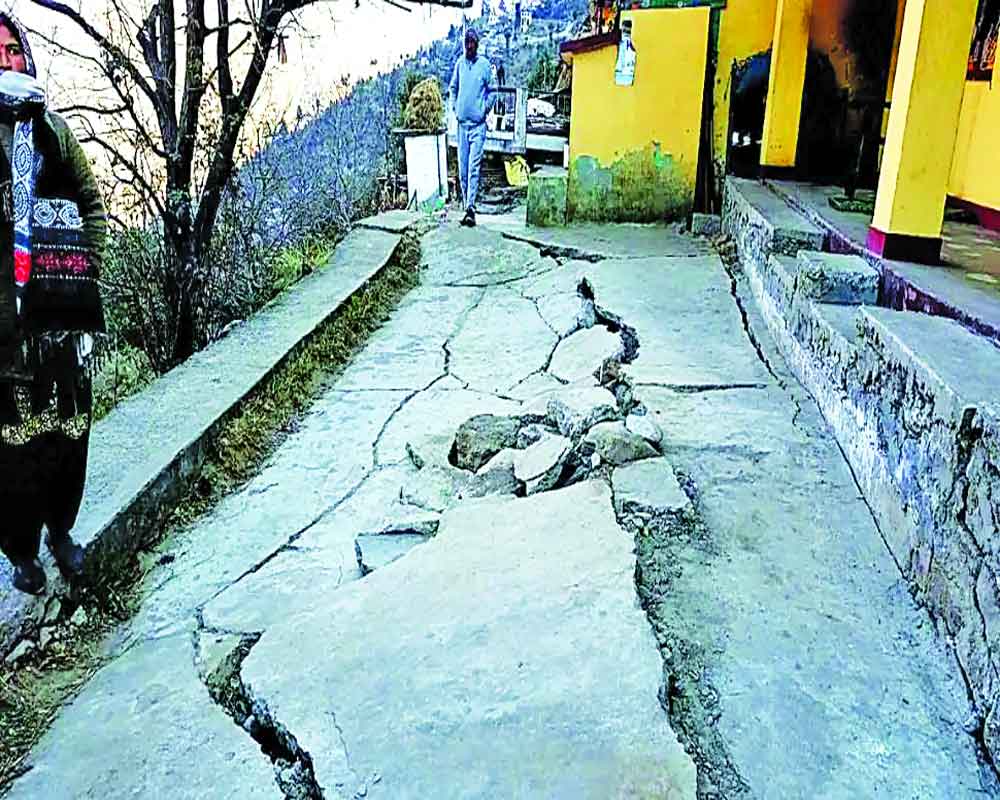A knee jerk approach won't help. A fresh development strategy for the Himalayas based on its ecosystem, needs to be worked out
The media is agog with the breaking news “Joshimath is sinking” and there is a situation of alarm around. However, the symptoms of this tragedy were visible for a long time and people in the town have been pleading for assistance from the state and district administration to help mitigate the damage or find solutions to the problem which has affected their health and home. In August 2022, experts from reputed institutions.
IIT-Roorkee, the Geological Survey of India, Wadia Institute of Himalayan Geology, Dehradun Central Building Research Institute, Roorkee, and the Uttarakhand Disaster Management Authority shared their apprehensions of an approaching disaster. They warned about the cracks surfacing not only in Joshimath but also in other areas of the Chamoli district. However, nobody took notice and worse still the officials turned a blind eye. Now, that the damage has been done, the government is proactive and has announced a host of remedial measures like ceasing the construction of the NTPC Hydro Power plant and along the Helang Bypass till further orders and all sorts of technical resources from far and wide are being summoned to Joshimath to mitigate the situation which has gone out of hand.
At this critical juncture, we need to analyze the reasons for the prevailing situation and try to find solutions. The first reason for this sorry state of affairs is that despite the suggestions of an expert group appointed by the Supreme Court that ‘the terrain above the Main Central Thrust (MCT) in general and above the winter snowline in particular, should be kept free from hydropower interventions’, the Central government allowed the commissioning of large Hydropower projects even after the 2013 Kedarnath tragedy. Again, in December 2014, the Ministry of Environment, Forests and Climate Change in an affidavit warned of direct and indirect impact on hydropower projects in the aggravation of floods in 2013 and suggested that ‘it is essential to demarcate areas in the higher Himalayan region that are naturally unstable’ for hydropower projects. In 2016, the Ministry of Water Resources told the Apex Court that a review of such projects was essential to protect the safety of people living in these areas. Instead of taking notice of these timely warnings, the Centre abated another assault on the Himalayas. In 2016, the Central government approved the 800 Km four lane Char Dham Highway Project in the hills which led to the widespread cutting of trees, destabilization of valley slopes, destruction of natural springs, and dumping of muck and debris in valleys below.
The second reason is the blatant disregard for following environmental norms while executing the projects. All large projects are subject to Environmental Impact Assessment (EIA) and must have an Environment Management Plan (EMP). The Char Dham project was broken into 53 projects of less than 100 Km each to escape these regulatory requirements. So, given the fact that the projects harmed the environment, the projects escaped all regulatory scrutiny and the need for a remedial EMP. Worst still, as per the study of the Vidi Centre for Legal Policy, between 2020 to 2022, 123 regulatory changes were made in environmental rules to relax rules and give exemptions to projects from the statutory requirements. The third reason was the unregulated promotion of religious tourism in ecologically sensitive areas at the cost of environmental degradation. The Himalayan terrain demands sustainable tourism and not mass tourism as is happening at present. The records indicate that during last year the daily footfall of tourists along the Char Dham route was reported to be around 58,000 and due to the convergence of tourists in such large numbers the plastic waste dumped in pits and cleaning operations resorting to open burning is highly hazardous. The Kedarnath floods in 2013 which were directly proportional to the unregulated rise in tourism, leading to the construction boom in the unsafe zone such as river valleys, floodplains, and slopes vulnerable to landslides was a wake-up call.
Now, let us focus on the solution part. The April 2022 report of the National Disaster Management Authority (NDMA) shows the mirror stating that ‘in the long term, it will be necessary to focus on finding alternative sources of energy, as the area appears to be environmentally sensitive’. A fresh development strategy for the Himalayas based on the region’s natural resources such as forest, water, biodiversity, and ecotourism needs to be worked out. The focus should be on small projects that would help provide a local energy supply without causing environmental degradation. The majority of the farmers in Uttarakhand Himalayan districts have given up traditional farming and most of the land lies fallow. There is a need to formulate an appropriate strategy for the well-being of the local population which should be based on traditional knowledge, environmentally friendly agricultural practices, construction practices, and local cultural aspects.
Joshimath episode is yet another timely warning to stop intrusive anthropogenic activities in the form of massive construction projects of building townships, highways, tunnels, railway tracks, and dams. The holistic approach toward the sinking Himalayas is the need of the hour. The sooner we understand, the better it is for the coming generations.
(The writer is a senior journalist and Chairman of the Panwar Group of Institutions, Solan, Himachal Pradesh.This is the concluding part of two-part series on the Joshimath disaster. The views expressed are personal)


























